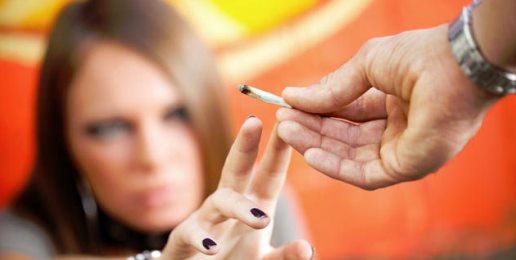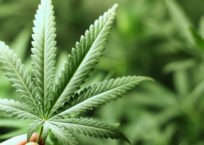
Written by Dr. Donald J. Hagler
Federal Law in the United States has prohibited the manufacture, sale, and distribution of marijuana for more than 70 years. However, with the discovery of potential medicinal properties of marijuana and the increasing misperception that the drug is harmless, there have arisen increased efforts to achieve its broad legalization despite persistent problems of abuse.
Medical use of marijuana has prompted many states to establish programs for sale of medically-prescribed marijuana. As public perception of marijuana’s safety has grown, some states have also passed voter-approved referenda legalizing recreational use of marijuana by adults. The result has been the same: limited legalization has led to greater availability of marijuana to youth.
How is Marijuana Used?
Whether used licitly or illicitly, marijuana is smoked or ingested. It may be smoked in hand-rolled cigarettes (joints), e cigarettes, pipes or water pipes (bongs), and cigars that have been refilled with a mixture of marijuana and tobacco (blunts). Marijuana emits a distinctive pungent usually sweet-and-sour odor when it is smoked. Marijuana is not so easily detectable, however, when ingested in candy, other foods or as a tea.
Has Legalization Escalated Youth Exposure to Marijuana?
There is evidence legalization of marijuana limited to medical dispensaries and/or adult recreational use has led to increased unintended exposure to marijuana among young children.
By 2011, rates of poison center calls for accidental pediatric marijuana ingestion more than tripled in states that decriminalized marijuana before 2005. In states which passed legislation between 2005 and 2011 call rates increased nearly 11.5 percent per year. There was no similar increase in states that had not decriminalized marijuana as of December 31, 2011.
Additionally, exposures in decriminalized states where marijuana use was legalized were more likely than those in non-legal states to present with moderate to severe symptoms requiring admission to a pediatric intensive care unit. The median age of children involved was 18-24 months.
Marijuana use by adolescents has grown steadily as more states enact various decriminalization laws. According to CDC data, more teens now smoke marijuana than cigarettes.
It is unclear, however, whether this trend indicates a causal relationship or mere correlation. There is some evidence legalization may encourage more youth to experiment with the drug. A national study of 6116 high school seniors, prior to legalization of recreational use in any state, found 10 percent of non-users said they would try marijuana if the drug were legal in their state. Significantly, this included large subgroups of students normally at low risk for drug experimentation, including non-cigarette smokers, those with strong religious affiliation, and those with peers who frown upon drug use. Among high school seniors already using marijuana, 18 percent said they would use more under legalization.
There is also evidence of medical marijuana diversion having a significant impact upon adolescents. For example, researchers in Colorado found that approximately 74 percent of adolescents in substance abuse treatment had used someone else’s medical marijuana. After adjusting for sex, race and ethnicity, those who used medical marijuana had an earlier age of regular marijuana use, and more marijuana abuse and dependence symptoms than those who did not use medical marijuana.
Conclusions from this study may not apply to adolescents as a whole due to the select population surveyed. There are broader adolescent population studies suggesting no significant increase in use due to enactment of medical marijuana laws.
These authors, however, caution that their results may not be definitive for five reasons: not all states with medical marijuana laws are represented in the various studies; the studies rely upon survey data from a voluntary survey (the Youth Risk Behavior Survey) which has the potential for reporting bias; there are gaps in the annual youth risk behavior data; the primary outcome measure was obtained from a single survey item; and the research is not long-term relative to when medical marijuana laws were implemented.
Consequently, while all reported their data did not find medical marijuana laws to significantly increase teen use, they also advised continued long-term observation and research.
Is Marijuana Medicine?
A recent article in the Journal of the American Medical Association noted there is very little scientific evidence to support the use of medical marijuana. Authors Samuel Wilkinson and Deepak D’Souza explain that medical marijuana is considerably different from all other prescription medications in that “[e]vidence supporting its efficacy varies substantially and in general falls short of the standards required for approval of other drugs by the US Food and Drug Administration (FDA).”
The FDA requires carefully conducted studies consisting of hundreds to thousands of patients in order to accurately assess the benefits and risks of a potential medication.
Although some studies suggest marijuana may palliate chemotherapy-induced vomiting, cachexia in HIV/AIDS patients, spasticity associated with multiple sclerosis, and neuropathic pain, there is no significant evidence marijuana is superior to FDA approved medications currently available to treat these conditions. Additionally, support for use of marijuana in other conditions, including post-traumatic stress disorder, Crohn’s disease and Alzheimer’s, is not scientific, relying on emotion-laden anecdotes instead of adequately powered, double-blind, placebo-controlled randomized clinical trials.
Also, to be considered a legitimate medicine, a substance must have well-defined and measurable ingredients that are consistent from one unit (such as a pill or injection) to the next. This consistency allows researchers to determine optimal dosing and frequency. Drs Samuel Wilkinson and Deepak D’Souza state:
“Prescription drugs are produced according to exacting standards to ensure uniformity and purity of active constituents … Because regulatory standards of the production process vary by state, the composition, purity, and concentration of the active constituents of marijuana are also likely to vary. This is especially problematic because unlike most other prescription medications that are single active compounds, marijuana contains more than 100 cannabinoids, terpenoids, and flavonoids that produce individual, interactive, and entourage effects.”
As a consequence, there are no dosing guidelines for marijuana for any of the conditions it has been approved to treat. And finally, there is no scientific evidence that the potential healthful effects of marijuana outweigh its documented adverse effects.
Sound ethics demands that physicians “First do no harm.” This is why a dozen national health organizations, including the College, presently oppose further legalization of marijuana for medicinal purposes.
If and when rigorous research delineates marijuana’s true benefits relative to its hazards, compares its efficacy with current medications on the market, determines its optimal routes of delivery and dosing, and standardizes its production and dispensing (to match that of schedule II medications like narcotics and opioids), then medical opposition will dissipate.
The Extent of Marijuana Abuse
In the United States, marijuana is the most frequently used illicit drug, with 23.9 million of those at least 12 years old having used an illegal drug within the past month in 2012.
The National Institute on Drug Abuse (NIDA)-funded 2013 Monitoring the Future study of the year 2012 showed that 12.7 percent of 8th graders, 29.8 percent of 10th graders, and 36.4 percent of 12th graders had used marijuana at least once in the year prior to being surveyed. They also found that 7, 18 and 22.7 percent respectively for these groups used marijuana in the past month.

Figure 1. Long-Term Trends in Annual Marijuana Use by Grade
After a period of decline in the last decade, marijuana use has generally increased among young people since 2007, corresponding with both its increased availability through limited legalization and a diminishing perception of the drug’s risks. The number of current (past month) users aged 12 and up increased from 14.5 to 18.9 million.
In 2010, 7.3 percent of all persons admitted to publicly funded treatment facilities were aged 12-17. Marijuana is the leading illicit substance mentioned in adolescent emergency department admissions and autopsy reports, and is considered one of the major contributing factors leading to violent deaths and accidents among adolescents.

Figure 2. Emergency Department Visits by Type of Substance Abuse
Such data indicate that marijuana use in adolescents is a major and growing problem. Given the widespread availability and abuse of marijuana, and its increasing decriminalization, it is important to examine the adverse clinical consequences of marijuana use.
Marijuana and Addiction
Marijuana is addictive. While approximately 9 percent of users overall become addicted to marijuana, about 17 percent of those who start during adolescence and 25-50 percent of daily users become addicted. Thus, many of the nearly 6.5 percent of high school seniors who report smoking marijuana daily or almost daily are well on their way to addiction, if not already addicted. In fact, between 70-72 percent of 12-17 year olds who enter drug treatment programs, do so primarily because of marijuana addiction.
Long-term marijuana users trying to quit report various withdrawal symptoms including irritability, sleeplessness, decreased appetite, anxiety, and drug craving, all of which can make it difficult to remain abstinent. These withdrawal symptoms can begin within the first 24 hours following cessation, peak at two to three days, and subside within one or two weeks follow drug cessation.
Behavioral interventions, including cognitive-behavioral therapy and motivational incentives (i.e., providing vouchers for goods or services to patients who remain abstinent) have proven to be effective in treating marijuana addiction.
Although no medications are currently available, recent discoveries about the workings of the endocannabinoid system offer promise for the development of medications to ease withdrawal, block the intoxicating effects of marijuana, and prevent relapse.
Is Marijuana a Gateway Leading to the Abuse of Other Illicit Drugs?
An additional danger associated with marijuana use observed in adolescents is a sequential pattern of involvement in other legal and illegal drugs. Marijuana is frequently a stepping stone that bridges the gap between cigarette and alcohol use and the use of other more powerful and dangerous substances like cocaine and heroin. This stage-like progression of substance abuse, known as the gateway phenomenon,
is common among youth from all socioeconomic and racial backgrounds. Additionally, marijuana is often intentionally used with other substances, including alcohol or crack cocaine, to magnify its effects. Phencyclidine (PCP), formaldehyde, crack cocaine, and codeine cough syrup are also often mixed with marijuana without the user’s knowledge.
Other Effects of Marijuana on the Brain
The main active chemical in marijuana is delta-9-tetrahydrocannabinol (THC). When marijuana is smoked, THC rapidly passes from the lungs into the bloodstream, which carries the chemical to the brain and other organs throughout the body. It is absorbed more slowly when ingested in food or drink.
In all cases, however, THC acts upon specific molecular targets on brain cells, called cannabinoid receptors. These receptors are ordinarily activated by chemicals similar to THC called endocannabinoids, such as anandamide. These receptors are naturally occurring in the body and are part of a neural communication network (the endocannabinoid system) that plays an important role in normal brain development and function. The highest density of cannabinoid receptors is found in parts of the brain that influence pleasure, memory, thinking, concentration, sensory and time perception, and coordinated movement. Marijuana over-activates the endocannabinoid system, causing the high and other effects that users experience. These effects include distorted perceptions, psychotic symptoms, difficulty with thinking and problem solving, disrupted learning and memory, and impaired reaction time, attention span, judgment, balance and coordination.
Chronic exposure to THC may also hasten the age-related loss of nerve cells. Numerous mechanisms have been postulated to link cannabis use, attentional deficits, psychotic symptoms, and neural desynchronization. The hippocampus, a component of the brain’s limbic system, is necessary for memory, learning, and integrating sensory experiences with emotions and motivations. THC suppresses neurons in the information-processing system of the hippocampus, thus learned behaviors, dependent on the hippocampus, also deteriorate.
Brain MRI studies now report that in young recreational marijuana users, structural abnormalities in gray matter density, volume, and shape occur in areas of the brain associated with drug craving and dependence. There also was significant abnormality measures associated with increasing drug use behavior. In addition to the regions of the nucleus accumbens and amygdala, the whole-brain gray matter density analysis revealed other brain regions that showed reduced density in marijuana users compared with control participants, including several regions in the prefrontal cortex: right/left frontal pole, right dorsolateral prefrontal cortex, and right middle frontal gyrus (although another small region in the right middle frontal gyrus showed higher gray matter density in marijuana users).
Countless studies have also shown that prefrontal cortex dysfunction is involved with decision-making abnormalities and functional MRI and magnetic resonance spectroscopy studies have shown that cannabis use may affect the function of this region.
Brain imaging with MRI was used to map areas of working memory in the brain and showed similar findings in normal and schizophrenic subjects who did not use marijuana, but decreases in the size of the working memory areas of the striatum and thalamus for those who had a history of cannabis use, that was more marked in those who used marijuana at a younger age and in users with schizophrenia.
In chronic adolescent users, marijuana’s adverse impact on learning and memory persists long after the acute effects of the drug wear off. A major study published in 2012 in Proceedings of the National Academy of Sciences provides objective evidence that marijuana is harmful to the adolescent brain. As part of this large-scale study of health and development, researchers in New Zealand administered IQ tests to over 1,000 individuals at age 13 (born in 1972 and 1973) and assessed their patterns of cannabis use at several points as they aged. Participants were again IQ tested at age 38, and their two scores were compared as a function of their marijuana use. The results were striking: Participants who used cannabis heavily in their teens and continued through adulthood showed a significant drop in IQ between the ages of 13 and 38—an average of eight points for those who met criteria for cannabis dependence. Those who started using marijuana regularly or heavily after age 18 showed minor declines.
By comparison, those who never used marijuana showed no declines in IQ. This is the first prospective study to test young people before their first use of marijuana and again after long-term use (as much as 20+ years later) thereby ruling out a pre-existing difference in IQ. This means the finding of a significant mental decline among those who used marijuana heavily before age 18, even after they quit taking the drug, is consistent with the theory that drug use during adolescence—when the brain is still rewiring, pruning, and organizing itself—has long-lasting negative effects on the brain.
Other studies have also shown a link between prolonged marijuana use and cognitive or neural impairment. A recent report in the journal Brain, for example, reveals neural-connectivity impairment in some brain regions following prolonged cannabis use initiated in adolescence or young adulthood.
Another longitudinal study followed 3385 patients who were between 18 and 30 years of age in 1985 for over 25 years. Cognitive function was assessed at the end of the study and included tests of verbal memory, processing speed, and executive functioning. 84.3 percent of the population reported past marijuana use, but only 11.6 percent continued using marijuana during middle age. For each five years of past marijuana use, verbal memory decreased significantly.
Effects on Activities of Daily Living
Consistent with marijuana’s impact upon the brain, research demonstrates marijuana has the potential to cause difficulties in daily life and/or worsen a person’s existing problems. Heavy marijuana users generally report lower life satisfaction, reduced mental and physical health, more relationship problems, and less academic and career success compared to their peers who come from similar backgrounds. Marijuana use is also associated with a higher likelihood of dropping out of school, workplace tardiness and absence, more accidents on the job with concomitant workman compensation claims, and increased job turnover.
A 2014 study combined the data of three investigations from Australia and New Zealand which compared a series of outcome measures of young adults according to their marijuana use at age 17. The researchers found a significant dose-response effect for each of these. After adjusting for co-variables, compared to those who never used cannabis prior to age 17 (OR 1.0), the odds of graduating from high school by age 25 dropped to 0.78 (95% CI,0.67-0.90) for those who used cannabis less than monthly to 0.61 (95% CI,0.45-0.81) for those using it monthly or more to 0.47 (95% CI,0.30-0.73) for those using it weekly or more to 0.37 (95% CI,0.20-0.66) for daily users. The decrease in attaining a university degree was almost identical. The odds of dependence on cannabis between the ages of 17 and 25 rose progressively from 2.06 (95% CI,1.75-2.42) for less than monthly users to 17.95 (95% CI,9.44-34.12) for daily users, and the odds of other illicit drug use between the ages of 23-25 rose from 1.67 (95% CI,1.45-1.92) for less than monthly users to 7.80 (95% CI,4.46-13.63) for those who were daily users prior to age 17. The odds of a making a suicide attempt between the ages of 17 and 25 were increased from 1.62 (95% CI,1.19-2.19) for less than monthly users to 6.83 (95% CI,2.04-22.9) for daily users.
While unadjusted odds ratios were progressively higher for progressively higher amounts of cannabis used before age 17 for both depression (between ages 17-25) and for welfare dependence (at ages 27-30 depending on the study), these differences were no longer significant after adjusting for co-variables. Although the greatest harm was among heavier users, it is most concerning that even less than monthly usage prior to age 17 was associated with a significantly lower educational achievement, and significantly higher rates of drug dependence and suicide attempts.
Marijuana and Mental Illness

Figure 3. Mood and Anxiety Disorders Among Users and Non-Users of Marijuana
A number of studies have shown an association between chronic marijuana use and mental illness. People who are dependent on marijuana frequently have other comorbid mental disorders including but not limited to anxiety, depression, suicidal ideation, and personality disturbances, including amotivation and failure to engage in activities that are typically rewarding (see figure 3).
Marijuana use is associated with a 7-fold increased risk of depression (OR 7.10, 95% CI,4.39-11.73) and a 5-fold increased risk of suicidal ideation (OR 5.38, 95% CI,3.31-8.73) when used alone, and with a 9-fold increased risk of depression (OR 9.15, 95% CI,4.58-18.29) and nearly 9-fold increased risk of suicidal ideation when marijuana plus other drugs are involved (OR 8.74, 95% CI 4.29-17.79).32 Daily marijuana use in young women has been associated with a five-fold increase in depression and anxiety.
Population studies also reveal an association between cannabis use and increased risk of schizophrenia. In the short term, high doses of marijuana can produce a temporary psychotic reaction involving hallucinations and paranoia. There is also sufficient data indicating that chronic marijuana use may trigger the onset or relapse of schizophrenia in people predisposed to it, perhaps also intensifying their symptoms.
A series of large prospective studies showed a link between marijuana use and the later development of psychosis with genetic variables, the amount of drug used, and the younger the age at which use began increasing the risk of occurrence. Although it is possible that pre-existing mental illness may lead some individuals to self-medicate with (abuse) marijuana and other illicit drugs, further prospective studies similar to those examining psychosis, will more firmly establish marijuana as a causative factor for other forms of mental illness.
A review of 10 studies evaluating the possible link between cannabis use and the development of psychotic disorders found nearly a 50 percent increased risk of psychosis among cannabis users versus nonusers. “Longitudinal studies show a consistent pattern of association between cannabis and psychosis, which could be indicative of a causal relationship.” “There is a strong body of epidemiologic evidence to support the view that regular or heavy cannabis use increases the risk of developing psychotic disorders that persist beyond the direct effects of exogenous cannabinoids.”
One mechanism that may contribute to this increased risk is the increase in neural noise caused by cannabis. Neural noise is random neural activity of the brain which reflects poor processing of information. The active constituent of cannabis (delta-9-tetrahydrocannabinol) has been reported to increase this neural noise which may play a role in the psychosis-like effects of cannabis.
Although there may be other factors that contribute to the apparent relationship between marijuana use and psychosis, it is an important factor to be considered, especially when there is a family history of mental illness.
Marijuana and Driving
Marijuana contributes to accidents while driving due to its significant impairment of judgment and motor coordination. Data from several studies was analyzed and documented that use of marijuana more than doubles a driver’s risk of involvement in an accident. Because they impede different driving functions, the combination of even low levels of marijuana and alcohol is worse than either substance alone.
Studies have shown a statistically significant increase in non-alcohol drugs detected in fatally injured drivers in the past decade. The most commonly detected non-alcohol drug was cannabinol, the prevalence of which increased from 4.2 percent in 1999 to 12.2 percent in 2010 (Z = -13.63, P < 0.0001). The increase in the prevalence of non-alcohol drugs was observed in all age groups and in both sexes. In this study, increases in the prevalence of narcotics and cannabinol detected in fatally injured drivers were particularly apparent.
Other Health Effects of Marijuana
Since marijuana contains many of the same compounds as tobacco, it has the same adverse effects on the respiratory system when smoked as tobacco. These include chronic cough, respiratory infections, and bronchitis. In the longer term emphysema and lung cancer are also among its effects. In fact, smoking marijuana is more harmful than tobacco for two reasons: first, because it contains more tar and carcinogens than tobacco, and secondly, because marijuana smokers tend to inhale more deeply and for a longer period of time as compared to tobacco smokers.
Marijuana use also has a variety of adverse, short- and long-term effects, especially on the cardiopulmonary system. Marijuana raises the heart rate by 20-100 percent shortly after smoking; this effect can last up to three hours. In one study, it was estimated that marijuana users had a 4.8-fold increase in the risk of heart attack in the first hour after smoking the drug. This elevated risk may be due to increased heart rate as well as the effects of marijuana on heart rhythms, causing palpitations and arrhythmias. This risk may be greater in older individuals or in those with cardiac vulnerabilities. Marijuana use has been found to increase blood pressure and heart rate and to decrease the oxygen-carrying capacity of the blood.
Chronic smoking of marijuana and its active chemical THC has consistently been shown to increase the risk of developing testicular cancer, in particular a more aggressive form of the disease. One study compared 369 Seattle-area men aged 18-44 with testicular cancer, to 979 men in the same age bracket without the disease. The researchers found that current marijuana users were 1.7 times more likely to develop testicular cancer than nonusers, and that the younger the age of initiation (below 18) and the heavier the use, the greater the risk of developing testicular cancer.
A similar study of 455 men in Los Angeles found that men with testicular germ cell tumors were twice as likely to have used marijuana as men without these tumors.
THC can also cause endocrine disruption resulting in gynecomastia, decreased sperm count, and impotence.
Effects of prenatal exposure to marijuana
The risk of using marijuana during pregnancy is unrecognized by the general public, but infants and children exposed prenatally to marijuana have a higher incidence of neurobehavioral problems. THC and other compounds in marijuana mimic the human brain’s cannabinoid-like chemicals, thus prenatal marijuana exposure may alter the developing endocannabinoid system in the fetal brain, which may result in attention deficit, difficulty with problem solving, and poorer memory.
Evidence especially suggests an association between prenatal marijuana exposure and impaired executive functioning skills beyond the age of three. Specifically, children with a history of exposure are found to have an increased rate of impulsivity, attention deficits, and difficulty solving problems requiring the integration and manipulation of basic visuoperceptual skills.
Rising Potency and Contaminants
The potency of marijuana has been increasing for decades, with THC concentrations rising from 4 percent in the 1980s to 14.5 percent in 2012 in samples confiscated by police. Some strains now contain as much as 30 percent THC. For a new user, this may mean exposure to higher concentrations of THC, with a greater chance of an adverse or unpredictable reaction. Increases in potency may account for the rise in emergency department visits involving marijuana use. For experienced users, it may mean a greater risk for addiction if they are exposing themselves to high doses on a regular basis.
However, the full range of consequences associated with marijuana’s higher potency is not well understood, nor is it known whether experienced marijuana users adjust for the increase in potency by using less. Since the legalization in Colorado, one certified lab there has reported that much of the marijuana they have studied and tested has been found to be laced with heavy metals, pesticides, fungus and bacteria.
Health Risks Underestimated
Health risks associated with marijuana use are often underestimated by adolescents, their parents, and health professionals. As explained above, there are newer, stronger forms of marijuana available than that which existed in 1960; current forms of marijuana are known to be three to five times more potent.
Parents underestimate the availability of marijuana to teens, the extent of their use of the drug, and the risks associated with its use. In a 1995 survey, the Hazelden Foundation found that only 40 percent of parents advised their teenagers not to use marijuana, 20 percent emphasized its illegal status, and 19 percent communicated to their teenagers that it is addictive.
Parental Monitoring Important
Research shows that appropriate parental monitoring can reduce drug use, even among those adolescents who may be prone to marijuana use, such as those with conduct, anxiety, or affective mood disorders.
Columbia University’s National Center on Addiction and Substance Abuse (CASA) found that adolescents were much less likely to use marijuana if their parents stated their disapproval.
“Parents who do not want their kids getting drunk and using drugs should begin by sending a strong message to their kids about the importance of avoiding alcohol. Our survey results this year show how important it is for teens to get a clear anti-use message from their parents, especially from Dad. Teens who get drunk monthly are 18 times more likely to report marijuana use than teens who do not drink; those who believe their father is okay with them drinking are two and a half times more likely to get drunk in a typical month. Therefore, parents who do not want their kids getting drunk and using drugs should begin by sending a strong message to their children about the importance of avoiding alcohol.”
In 2011, past month use of illicit drugs, cigarettes, and binge alcohol use were lower among youth aged 12 to 17 who reported that their parents always or sometimes engaged in monitoring behaviors compared to youths whose parents seldom or never engaged in monitoring behaviors. The rate of past month use of any illicit drug was 8.2 percent for youths whose parents always or sometimes helped with homework compared with 18.7 percent among youth who indicated that their parents seldom or never helped.
Columbia Center for Alcohol and Substance Abuse found that teens who have frequent family dinners (five to seven per week) were less likely to have used marijuana. Compared to teens who had infrequent family dinners (2 or fewer per week), teens who had frequent family dinners were almost 1.5 times likelier to have said they had an excellent relationship with their mother and their father. The report also found that compared to teens who said they had an excellent relationship with their fathers, teens that had a less than very good relationship with their father were:
- Almost 4 times likelier to have used marijuana
- Twice as likely to have used alcohol
- 2.5 times as likely to have used tobacco
Compared to teens who said they had an excellent relationship with their mothers, teens who had a less than very good relationship with their mother were:
- Almost 3 times likelier to have used marijuana
- 2.5 times as likely to have used alcohol
- 2.5 times likelier to have used tobacco
Consequently, the College encourages parents to take advantage of the “family table,” and to become involved in drug abuse prevention programs in the community or in the child’s school in order to minimize the risk of their children experimenting with drug use.
In Conclusion
In summary, marijuana use is harmful to children and adolescents. For this reason, the American College of Pediatricians opposes its legalization for recreational use and urges extreme caution in legalizing it for medicinal use.
Likewise, the American Academy of Child and Adolescent Psychiatry (AACAP) recently offered their own policy statement opposing efforts to legalize marijuana. They similarly pointed out that
“marijuana’s deleterious effects on adolescent brain development, cognition, and social functioning may have immediate and long-term implications, including increased risk of motor vehicle accidents, sexual victimization, academic failure, lasting decline in intelligence measures, psychopathology, addiction, and psychosocial and occupational impairment.”
Thus the AACAP (a) opposes efforts to legalize marijuana, (b) supports initiatives to increase awareness of marijuana’s harmful effects on adolescents, (c) supports improved access to evidence-based treatment, rather than emphasis on criminal charges, for adolescents with cannabis use disorder, and (d) supports careful monitoring of the effects of marijuana-related policy changes on child and adolescent mental health. The College agrees with this position on marijuana.
The College urges parents to do all they can to oppose the legalization of marijuana, such as working with elected officials against the drug’s legalization and scrutinizing a candidate’s positions on this important child’s issue when making voting decisions. The College encourages legislators to consider the establishment and generous funding of more facilities to treat marijuana addiction.
Children look to their parents for help and guidance in working out problems and in making decisions, including the decision to not use drugs. Therefore, parents should be role models, and not use marijuana or other illicit drugs. Finally, these reports strikingly emphasize the need for parents to recognize and discuss these serious health consequences of marijuana use with their children and adolescents. They also point to the requirement for medical experts and legislators to seriously discuss and review these observations prior to promoting any state or federal effort considering legalization.
Dr. Donald J. Hagler is a Professor of Pediatrics, Consultant in Pediatric Cardiology and Cardiovascular Diseases Mayo College of Medicine, Mayo Clinic.
This is a position paper of the American College of Pediatricians which has been republished with permission. For the original version with extensive footnotes and references, please consult the ACP website.





















